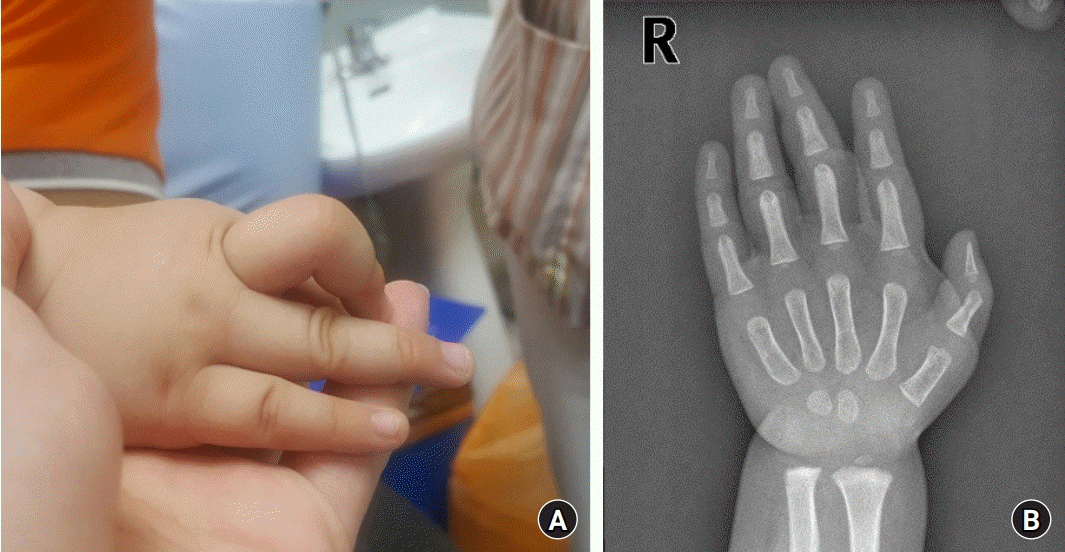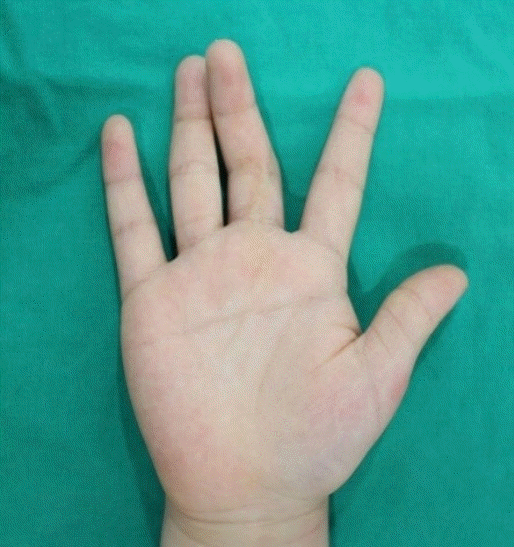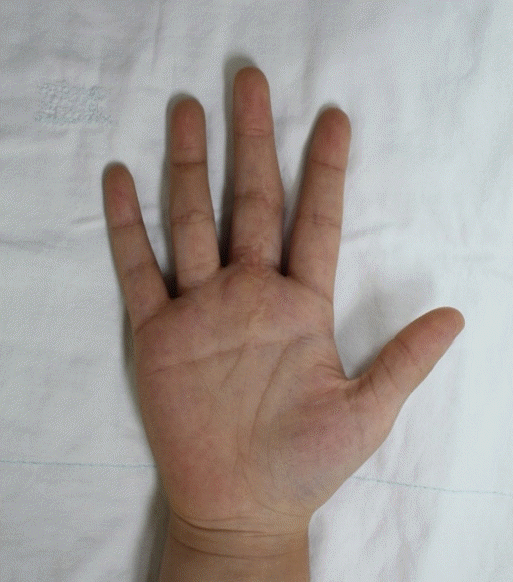Abstract
Pediatric trigger finger (PTF) is a rare hand disorder caused by various anatomic abnormalities and systemic illnesses. We report a case of PTF in a 16-month-old boy, revealing a flexion deformity of his right middle finger. We noted an abnormally proximal location of Camper’s chiasm and bulging of the flexor digitorum profundus intraoperatively. We released the A1 pulley completely and resected an ulnar slip of the flexor digitorum superficialis (FDS). The short-term outcome was satisfactory; however, the patient experienced a mild flexion deformity and ulnar deviation of the right middle finger at a 4-year follow-up visit. During reexploration, we noted severe scar adhesion along the previously cut end of the ulnar slip of the FDS. Therefore, we performed en-bloc scar tissue release with additional resection of the remaining radial slip of the FDS. To prevent recurrence after PTF release, close monitoring with short-term follow-up and early physiotherapy should be emphasized.
Pediatric trigger finger (PTF) presenting in a finger other than the thumb is a very rare hand disorder, showing one-tenth the prevalence rate of pediatric trigger thumb (PTT) [1]. Because its etiology and pathophysiology remain incompletely understood, PTF tends to be initially misdiagnosed, leading to a delay in definitive treatment by experienced hand surgeons. Unlike PTT and adult trigger finger, which are caused by a developmental size mismatch between the flexor tendon and its sheath, PTF is associated with anatomical variations of the flexor tendons, metabolic and inflammatory conditions, and even minor trauma [1-4].
Children with PTF usually present with locked flexion of the digit rather than clicking or triggering. For the proper treatment of PTF, hand surgeons should be aware of the possible causes and tailor their management accordingly. Currently, A1 pulley release with resection of one slip of the flexor digitorum superficialis (FDS) is the mainstay of the surgical release of PTF [3-6]. However, recurrence is frequently reported and complications such as proximal interphalangeal (PIP) joint contracture, decreased range of motion, and delayed motor skill development have been reported, necessitating further secondary procedures [4,6-7].
By sharing a case of an unexpected complication after proper surgical treatment of PTF, we would like to call hand surgeons’ attention to the need for a more cautious approach to PTF management.
A 16-month-old boy presented with a flexion deformity of his right middle finger without any triggering or clicking. There was no history of perinatal metabolic or rheumatologic illnesses. The patient had normally achieved all developmental milestones and did not have any history of trauma. Flexion deformity of his right middle finger ranging from 50° to 60° at the PIP joint and 10° to 20° at the distal interphalangeal joint was noted (Fig. 1A). Plain radiographs of both hands showed no bony abnormality (Fig. 1B) and ultrasonography confirmed the integrity of the flexor tendons.
Under general anesthesia, a Bruner-type palmar-digital incision was performed from the proximal palmar crease to the proximal half of the middle phalanx. Two slips of the FDS tendon passed separately around the flexor digitorum profundus (FDP) more proximally to the A1 pulley level. We exposed Camper’s chiasm, noted decussation of the FDS, which was abnormally located 1 cm proximal to A1 pulley (Fig. 2A) and identified concomitant longitudinal bulging of the FDP. While protecting the neurovascular structures carefully with Ragnell retractors, the A1 pulley was split longitudinally, but the flexion deformity was not corrected completely. Therefore, we additionally resected the ulnar slip of the FDS from Camper’s chiasm to the FDS insertion site, with a length of 24 mm (Fig. 2B, 2C). We then confirmed the correction of the flexion deformity and normal joint function by passive extension. Bulky dressings with short arm splint were applied for about 3 weeks postoperatively, to prevent hematoma formation or wound dehiscence considering noncompliance due to his age. The short-term outcome after surgery was satisfactory, as the patient was able to flex and extend his diseased finger without any deformity. His parents seemed to have been neglectful about postoperative care including active motion therapy and follow-up monitoring was lost postoperatively.
The patient showed up at 4 years after surgery and the patient’s right middle finger had a flexion contracture deformity in the PIP joint accompanied by mild ulnar deviation (Fig. 3). Reexploration was scheduled and during the procedure, we noted severe scar adhesion along both previously cut ends of the ulnar slip of the FDS (Fig. 4A). In addition to the scar tissue release, the remaining radial slip of the FDS from Camper’s chiasm to the FDS insertion site was resected with a length of 24 mm to release the flexion contracture of the PIP joint. The residual proximal cut end of the radial slip of the FDS was sutured to the intact FDP at the metacarpophalangeal (MCP) level using 5-0 nylon (Fig. 4B). Immediately after the operation, active motion therapy was initiated. At a 1-year follow-up after the second operation, a good joint motion was obtained, and it was confirmed that the flexion deformity in his right middle finger had been corrected (Fig. 5).
Written informed consent was obtained from the patient for the publication of this report including all clinical images.
PTF is a different disorder from PTT or adult trigger finger in its etiopathology and management. PTF is usually diagnosed at the middle and ring fingers before the age of 1 year with an even sex distribution [5,8]. Anatomic anomalies of the flexor tendons, such as a narrow pulley system, flexor tendon nodules, bulky flexor tendons, narrow or proximal decussation of the FDS, sesamoid bone interposition, and palmar plate injury have been considered to cause PTF [1-4,9]. Furthermore, underlying conditions such as mucopolysaccharidosis, juvenile rheumatoid arthritis, Ehlers-Danlos syndrome, and trisomy 18 have been related to PTF [3,7,9].
Children with PTF typically show a flexed posture of the digit without any clicking or triggering [5]. We can palpate a volar mass similar to Notta’s nodule over the MCP joint, probably due to a widened FDS or FDP [3]. Plain film radiographs may reveal bony masses, such as osteochondromas or calcifications due to previous trauma [9]. Ultrasonography could be helpful for evaluating the severity of PTF and its response to treatment [1,5,9].
Although the published management strategies reported good outcomes, there is no general consensus on the best method to treat PTF [3,5]. Spontaneous resolution does occur occasionally, and splinting has been reported to be effective [8]. Because the age at operation and duration of symptoms do not affect the surgical outcomes, noninvasive therapy can be tried first [8]. Steroid injections and percutaneous A1 pulley release are not recommended due to their different pathophysiology. Surgical release should be considered when symptoms do not subside after 6 months of conservative therapy or at the age of 3 years [8,10].
Given the diverse etiologies of PTF, surgery should be tailored to the intraoperative findings. Therefore, various surgical procedures have been suggested. A1 pulley release and resection of one arbitrary slip of the FDS tendon are widely used with high success rates, regardless of the underlying abnormalities [3-6]. Resection of both slips of the FDS tendon along with A1 pulley release, A3 pulley release, and release of the proximal one-third of the A2 pulley have also been suggested when the pathology is identified [1,4,7]. It is important to check the normal finger excursion by manual passive extension and flexion before skin closure. If PIP joint extension is persistently restricted, the flexor tendons should be closely inspected for other anatomical anomalies, especially between the levels of the A1 and A2 pulleys, where anomalies frequently exist [2].
Recurrence after PTF release is not uncommon, with reported rates as high as 44% [7]. Bae et al. [6] reported a recurrent case of PTF in which an aberrant muscle belly arising from the FDS tendon was discovered during reoperation, which should have been found in the initial operation. Therefore, being fully aware of possible anatomical anomalies and exploring the entire flexor mechanism that may cause the flexion deformity is important to prevent recurrence.
In our case, we believe that recurrence can be attributed to three factors; (1) a broader initial incision to confirm the definite release, (2) long immobilization with bulky dressings, and (3) the guardian’s poor compliance with active motion therapy. Insufficient postoperative management seems to induce severe scar adhesion, resulting in flexion contracture and ulnar deviation deformity of the affected digit. The mechanical restraints inducing contracture are multifactorial, including adhesions of the volar plate and retinacular ligaments to the collateral ligaments, contraction of the superficial fascia, and flexor tendon sheath and joint space narrowing. Positional contracture is caused by FDS shortening or degenerative hypertrophy. Resecting both slips of the FDS is recommended in cases of persistent flexion contracture of the PIP joint [3]. Theoretically, complete FDS resection would reduce grip strength; therefore, a warning should be given before surgery. If contracture persists even after total resection, consideration should be given to exploring more proximal anatomy (e.g., the palm or forearm) [6].
In conclusion, hand surgeons should be aware of the causative anatomical anomalies responsible for PTF, which are quite different from those of PTT and adult trigger finger. It is also mandatory to correct the underlying etiology extensively, beyond simple A1 pulley release at the first surgical exploration to prevent recurrence. Moreover, proper education of patients’ guardians should be emphasized for successful outcomes, with management including regular surveillance and early active motion (e.g., passive exercises led by the guardians).
References
1. Bhaban N, Devale M, Munoli A. Congenital bilateral multiple trigger fingers in a 5-year-old child. World J Plast Surg. 2017; 6:380–2.
2. Le Viet D, Tsionos I, Boulouednine M, Hannouche D. Trigger finger treatment by ulnar superficialis slip resection (U.S.S.R.). J Hand Surg Br. 2004; 29:368–73.
3. Shah AS, Bae DS. Management of pediatric trigger thumb and trigger finger. J Am Acad Orthop Surg. 2012; 20:206–13.
4. Schaverien MV, Godwin Y. Paediatric trigger finger: Literature review and management algorithm. J Plast Reconstr Aesthet Surg. 2011; 64:623–31.
5. Giugale JM, Fowler JR. Trigger finger: adult and pediatric treatment strategies. Orthop Clin North Am. 2015; 46:561–9.
6. Bae DS, Sodha S, Waters PM. Surgical treatment of the pediatric trigger finger. J Hand Surg Am. 2007; 32:1043–47.
7. Cardon LJ, Ezaki M, Carter PR. Trigger finger in children. J Hand Surg Am. 1999; 24:1156–61.
8. Moon WN, Suh SW, Kim IC. Trigger digits in children. J Hand Surg Br. 2001; 26:11–2.
9. de Oliveira RK, Delgado PJ, Geist JG. Pediatric trigger finger due to osteochondroma: a report of two cases. Hand (N Y). 2017; 12:99–105.
10. Steenwerckx A, De Smet L, Fabry G. Congenital trigger digit. J Hand Surg Am. 1996; 21:909–11.
Fig. 1.
(A) A 16-month-old boy showed flexion deformity of his right middle finger. Active and passive extension was limited. (B) No bony abnormality was found on the trigger digit.

Fig. 2.
Primary operation. (A) An abnormal location of Camper’s chiasm was noted, proximal to the A1 pulley (asterisk). Intact flexor digitorum profundus (arrow) and flexor digitorum superficialis (dotted arrow) were noted. (B) Resection of the ulnar slip of the flexor digitorum superficialis (FDS) with a length of 24 mm from Camper’s chiasm to the FDS insertion site was performed. (C) The remaining radial-side slip of the FDS was retracted using a Ragnell retractor (arrow, flexor digitorum profundus; dotted arrow, remaining FDS; arrowhead, A2 pulley).

Fig. 3.
Ulnar deviation and mild flexion deformity of the right middle finger were noted at a 4-year follow-up.

Fig. 4.
Second reoperation. (A) The remaining radial slip of the flexor digitorum superficialis (FDS) was retracted using a Ragnell retractor (arrow, flexor digitorum profundus [FDP]; arrowhead, A2 pulley; dotted arrow, FDS). (B) After resection of the remaining radial slip of the FDS from Camper’s chiasm to the FDS insertion site, the residual FDS slip was sutured to the FDP.





 PDF
PDF Citation
Citation Print
Print




 XML Download
XML Download